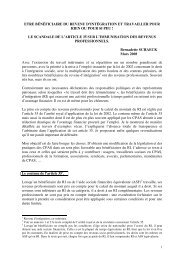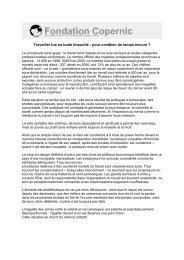Awra Amba RJ 300612 EN - Contacter un comité local d'Attac
Awra Amba RJ 300612 EN - Contacter un comité local d'Attac
Awra Amba RJ 300612 EN - Contacter un comité local d'Attac
You also want an ePaper? Increase the reach of your titles
YUMPU automatically turns print PDFs into web optimized ePapers that Google loves.
4. Social organisation<br />
We describe here the main aspects of the <strong>Awra</strong> <strong>Amba</strong> comm<strong>un</strong>ity: the structures of the comm<strong>un</strong>ity,<br />
its economic activities, then its social relationships, through gender equality, equality in work, what<br />
deals with family (marriage, divorce, and family household building), the specific and original<br />
position of children, the solidarity with the weakest, the f<strong>un</strong>eral, and finally the management modes<br />
of the conflicts internal within the comm<strong>un</strong>ity.<br />
This is essentially the social capital of the comm<strong>un</strong>ity: a set of values, behaviours and modes of<br />
social organisation of which that capital is composed, which play a key role in the successful<br />
development of <strong>Awra</strong> <strong>Amba</strong> (Ya08/136).<br />
4.1. Institutions<br />
<strong>Awra</strong> <strong>Amba</strong> is organised into two structures (Yi07/47; Jo10b/5):<br />
- The comm<strong>un</strong>ity, which contains especially all inhabitants of the village, who share values and a<br />
life style. It was created in 1972. This comm<strong>un</strong>ity is in fact split into those who live in <strong>Awra</strong><br />
<strong>Amba</strong> and who really follow the common rules (439 persons at the beginning of 2011), and<br />
external members living elsewhere (Bahar Dar, Addis Ababa etc) who participate to one or two<br />
meetings with <strong>local</strong> members, and who form a sort of supporting and advising network. Zumra<br />
considers all those who share the <strong>Awra</strong> <strong>Amba</strong> values can be members of the comm<strong>un</strong>ity,<br />
irrespective of where they live.<br />
- The cooperative or <strong>un</strong>ion, fo<strong>un</strong>ded in 1986 by an original core group of 19 people and which<br />
always increased to reach 143 adult members in 2010 (81 women and 62 men, i.e. with their<br />
children 325 people). It is a work and life collective, within the comm<strong>un</strong>ity. 87 comm<strong>un</strong>ity<br />
members are therefore not members of the cooperative in 2010; among them, adults work<br />
independently, usually weaving at home. We can assess the number of these adults to more than<br />
thirty according to figures of Table 1 and age distribution of Figure 3. The cooperative did not<br />
accept any new member in 2010 due to the lack of work opport<strong>un</strong>ity.<br />
According to the chief guide interviewed by Yi07/47, to be member of the comm<strong>un</strong>ity does not<br />
allow to participate in the comm<strong>un</strong>ity tasks, to share any benefit of the comm<strong>un</strong>ity or to have access<br />
to all cooperative services; only the cooperative members are really organised, as confirmed by<br />
Crespo (2012). What about the comm<strong>un</strong>ity members living in <strong>Awra</strong> <strong>Amba</strong> and who do not belong to<br />
the cooperative, in terms of participation to <strong>local</strong> tasks, which many committees described below<br />
deal with: are they excluded from any comm<strong>un</strong>ity decision? Their situation is not clear (Question 17<br />
in Annex).<br />
Like any association, the cooperative comprises a general assembly of the membership, an executive<br />
management, a secretariat and an auditing section (article 11 of the 1999 Comm<strong>un</strong>al Statute)<br />
(Me09/40).<br />
The most important decisions – the annual income distribution, the planning and expansion of<br />
economic activities, the election of committees – are debated and voted by adults over the age of 18<br />
in general assemblies (At05/60): these general strategic assemblies are held once a year (At05/60;<br />
Ya08/115; Jo10b/9), or about four times a year as necessary according to Crespo (2012), whereas it<br />
seems that less important general assemblies – also so-called development days – are held once a<br />
week (At05/60) (Question 18 in Annex). These weekly development days are held on Tuesday <strong>un</strong>der<br />
a big tree in the village centre, each participant spinning at the same time (Picture 5). This choice of<br />
Tuesday and the habit of spinning cotton started when Zumra's former wife lost her daughter: the<br />
41 /85

















